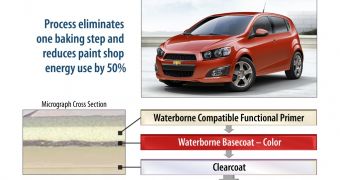Some people still have problems adjusting to the idea that electric and hybrid cars might be the answer to our future transportation needs, despite the fact that they are becoming more and more environmentally conscious.
So if you still plan to buy a conventionally-powered vehicle, yet you are concerned about its carbon footprint, American auto giant General Motors thought of other ways to cut emissions.
Specifically, the company is the first automaker in the United States to use a unique water-based “three-wet” paint process, which is now being applied to the 2012 Chevrolet Sonic.
The process in question eliminates the need for a primer bake oven, normally used between the primer and color-coating layers.
The work is done in the Orion Assembly Center, which allows three layers of paint to be applied one after another while still wet before a single trip though the oven.
The new paint shop was reportedly engineered to minimize energy use while reducing solvent emissions. The “three-wet” paint process only reduces the paint shop footprint by 10 percent.
“Cutting our greenhouse gas emissions and reducing our energy consumption were key to implementing our water-based ‘three-wet’ paint process,” stated Mauricio Pincheira, paint manager at Orion.
“We want to provide a durable paint that impresses our first-time Sonic customers and maintain the tough environmental standards we have across the company,” he added,
Together with other methods, Orion’s paint shop uses 50 percent less process energy per vehicle than the shop it replaced. It is also heated by natural and landfill gas, which results in less emissions than coal-fired boilers.
When full shift production is achieved, Orion’s new paint shop will reduce greenhouse gas emissions by about 80,000 metric tons per year – equivalent to the annual emissions from 14,000 vehicles – and solvent emissions by about 108,000 pounds of solvent per year.
According to General Motors, these cost-saving paint process improvements trimmed the manufacturing costs by about $40 per vehicle.

 14 DAY TRIAL //
14 DAY TRIAL //